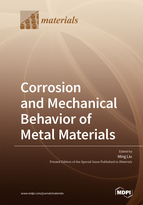Corrosion and Mechanical Behavior of Metal Materials
A special issue of Materials (ISSN 1996-1944). This special issue belongs to the section "Metals and Alloys".
Deadline for manuscript submissions: closed (20 March 2023) | Viewed by 19057
Special Issue Editor
Interests: corrosion; SCC; corrosion fatigue
Special Issues, Collections and Topics in MDPI journals
Special Issue Information
Dear Colleagues,
Many structural metal materials work under the coupling condition of the load and corrosion environment. Therefore, it is very necessary to study the corrosion and mechanical behavior of metal structural materials. The corrosion behaviors of metals under the coupling condition of the mechanics and corrosion environment mainly include stress corrosion cracking, hydrogen-induced cracking, corrosion fatigue, erosion corrosion, wear corrosion, etc. From the macroscopic or microscopic point of view, these corrosion damages all involve the fracture process, and fractures are caused by environmental factors, also known as environmental fractures. Thus, this Special Issue, ”Corrosion and Mechanical Behavior of Metal Materials”, will focus on the environmental fracture behavior of metal materials. We hope that colleagues in the relevant field can contribute to the topic, including but not limited to experimental, computational, or theoretical studies on environmental corrosion fracture of high-strength metal materials.
Dr. Ming Liu
Guest Editor
Manuscript Submission Information
Manuscripts should be submitted online at www.mdpi.com by registering and logging in to this website. Once you are registered, click here to go to the submission form. Manuscripts can be submitted until the deadline. All submissions that pass pre-check are peer-reviewed. Accepted papers will be published continuously in the journal (as soon as accepted) and will be listed together on the special issue website. Research articles, review articles as well as short communications are invited. For planned papers, a title and short abstract (about 100 words) can be sent to the Editorial Office for announcement on this website.
Submitted manuscripts should not have been published previously, nor be under consideration for publication elsewhere (except conference proceedings papers). All manuscripts are thoroughly refereed through a single-blind peer-review process. A guide for authors and other relevant information for submission of manuscripts is available on the Instructions for Authors page. Materials is an international peer-reviewed open access semimonthly journal published by MDPI.
Please visit the Instructions for Authors page before submitting a manuscript. The Article Processing Charge (APC) for publication in this open access journal is 2600 CHF (Swiss Francs). Submitted papers should be well formatted and use good English. Authors may use MDPI's English editing service prior to publication or during author revisions.
Keywords
- stress corrosion cracking
- hydrogen-induced cracking
- corrosion fatigue
- erosion corrosion
- wear corrosion







